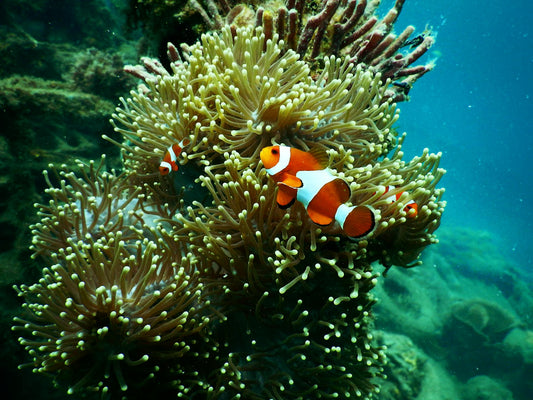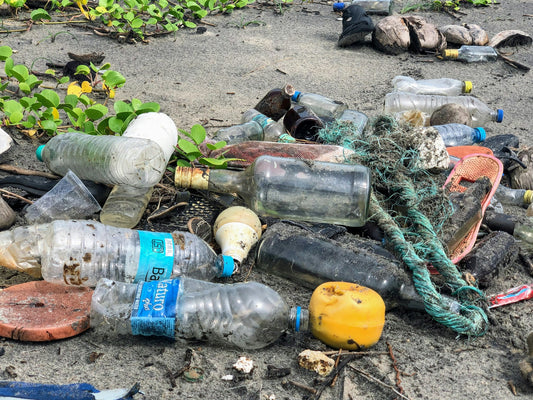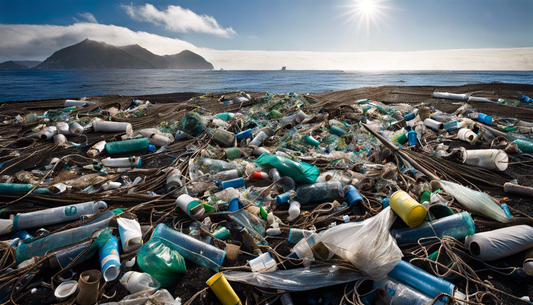Share
Research shows that microplastics pose a significant threat to our environment and even to our own health.
In recent years, we’ve seen growing criticism towards the global beauty industry, which uses microplastics in cosmetics for various reasons
- Exfoliating properties
- Texture
- Shelf life extension
- Cost reduction
- Visual appeal
By making informed choices and supporting sustainable brands, you can make your contribution to solving this problem.
--------------------------
What are Microplastics in Cosmetics?

Microplastics are tiny plastic particles that are often invisible to the naked eye, according to the official definition, they measure less than 5mm in size.
Thinking about microplastics, many envision secondary microplastics, which occur if larger pieces of plastic break down over time. However, there is a whole category of primary microplastics that are intentionally produced and added to products, especially in the cosmetic industry.
The cosmetic industry is known for the use of two types of microplastic, microbeads and liquid microplastics.
Microbeads are tiny solid particles that you may for example know from toothpaste, where they are added to enhance scrubbing and for a visual effect.
Liquid microplastics on the other hand are polymers that dissolve in water, but never biodegrade.
The cosmetics industry uses microplastics for various reasons:
- Exfoliating properties: Microplastics are added to products like toothpaste, body scrub, or facial cleanser for exfoliating properties.
- Texture: Some products contain microplastics to enhance the texture, consistency, and spreadability of products like facial cream.
- Shelf life extension: Some microplastics, especially liquid microplastics act as stabillizers and extend the shelf file of cosmetics by preventing separation of components and deterioration.
- Cost reduction: Some manufacturers include microplastics to simply increase margins by filling formulas with this cheap ingredient.
- Visual appeal: Some products contain microplastic to enhance products visually, for example in the form of glitter in makeup.
While the use of microbeads has attracted a lot of attention in recent years that even led to widespread bans, liquid microplastics are just as dangerous and still widely used.
The Dangers of Microplastics in Cosmetics

Microplastics in cosmetics have become a sincere environmental concern due to their non-biodegradable nature and their potential to accumulate in ecosystems.
When microplastics are washed down the drain, they often are too small for regular water treatment filtration. This means they finally end up in rivers, lakes, and oceans, where they become a part of the food chain.
In fact, there have been many worrying studies that show the widespread occurence of microplastics in fish and marine mammals. Not only does that directly threaten marine life and our ecosystem, it also threatens our own health.
While the full extent of the health implications is still being studied, there is significant evidence suggesting that microplastics in cosmetics adverse effects on human health.
Studies have indicated that humans consume about a credit card worth of microplastics every week, with implications that span from inflammation to cellular damage even the alteration of DNA.
If you're interested in a more detailed view on the threat of microplastics to human health and how to help remove microplastics from your body, check out our dedicated article on the issue.
How to Avoid Microplastics in Cosmetics

As consumers, we can play a vital role in combating the issue of microplastics in cosmetics. By becoming informed and conscious buyers, we can make choices that promote environmentally friendly and sustainable products.
Look for brands that have committed to being microplastic-free or opt for natural and organic alternatives. Additionally, consider using exfoliating products with natural ingredients like sugar, salt, or plant-based fibers.
If you check the label of a product, the following most commonly seen ingredients should be a red flag:
- Polyethylene (PE): PE is found in many makeup products, skin cleaners, and skin care products. It is used in cosmetics to increase abrasion, as a binding or bulking agent, an oral care agent, or to increase viscosity.
- Polyethylene terephthalate (PET): PET is often found in foundations, hair products, and nail products. It increases the thickness of a product and forms a thin water resistant coating on nails, skin, or hair.
- Nylon (PA): Nylon is broadly used in body and hand preparations, makeup and nail products, and skin refreshers. Among others, it is known to serve as a bulking agent and absorbent.
- Polypropylene (PP): PP can be found in various products, but especially in makeup (eyeliner and foundation). It forms a coating, acts as a binding agent and thickener, or to increase abrasion.
- Polymethyl methacrylate (PMMA): PMMA is mainly used in makeup, hair, and nail products, where it forms a film or acts as a thickener.
- Polyurethane: Polyurethane is especially used to form a protective film, as it is found in high protection sunscreen and other lotions.
- Acrylates Copolymer: Acrylates Copolymers are mainly used as stabilizers in hair products, makeup and lipstick, nail products, body washes, sunscreens and anti-ageing treatments.
As a rule of thumb: if you read anything "Poly...", be sceptical!
Make sure you stay posted on the ingredients that represent microplastics. There are helpful tools like the codecheck app and ingredient lists on beatthemicrobead.org that help your choosing the right products.
Support Sustainable Brands:

You may be overwhelmed by the amount of information regarding microplastics in cosmetics, especially, if the issue is new to you. Luckily there are more and more sustainable brands that offer plastic-free products with natural ingredients only.
At SWOP, we conduct thorough research and test every single product, before we offer it in our online store. This ensures you always get the best plastic-free skin care products at a reasonable price.
You can rest assured that with those products you wont be rubbing microplastics into your body.
We hope you enjoyed this article. If you want to read more like this, make sure to check out our Blog and follow us on Instagram. If you are interested in truly sustainable products, check out our Shop.








